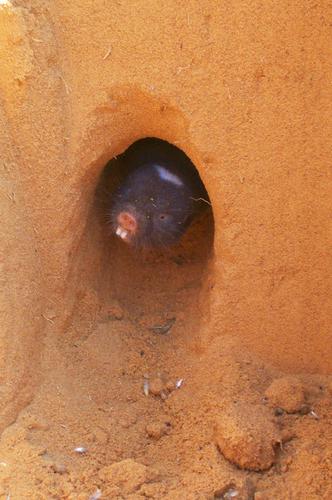Our official English website, www.x-mol.net, welcomes your
feedback! (Note: you will need to create a separate account there.)
The oestrous cycle of the Damaraland mole-rat revisited: evidence for induced ovulation
Journal of Zoology ( IF 1.9 ) Pub Date : 2021-01-12 , DOI: 10.1111/jzo.12860 C. Voigt 1 , K. Medger 1 , N. C. Bennett 1
Journal of Zoology ( IF 1.9 ) Pub Date : 2021-01-12 , DOI: 10.1111/jzo.12860 C. Voigt 1 , K. Medger 1 , N. C. Bennett 1
Affiliation

|
African mole-rats (family Bathyergidae) show a wide variety of social organization, from strictly solitary to highly social. Within the family, both modes of ovulation, spontaneous and induced, have been found and are thought to relate to seasonality of reproduction and opportunities for dispersal. Damaraland mole-rats (Fukomys damarensis) are cooperative breeders, which breed year-round and exhibit high reproductive skew. Reproduction is monopolized by a single female (queen) in each group, and non-reproductive females in the presence of the queen are anovulatory. The species was previously described as being a spontaneous ovulator; however, subsequent attempts to determine the length of the oestrous cycle have failed. Therefore, we revisited this subject by studying the urinary progesterone and oestradiol profiles over a period of 7 weeks and the ovarian histology of females kept under different social conditions. The first experiment shows that average urinary progesterone concentrations of breeder females paired with a vasectomized male (full physical contact) are significantly higher than those of breeder females kept singly, non-breeder females kept singly and non-breeder females kept within their natal group. In the second experiment, we subjected females consecutively to different experimental conditions: full physical contact (stage 1), isolation (stage 2), non-physical contact (stage 3) and measured their steroid hormone profiles. The females showed elevated concentrations of urinary progesterone during the phase of full physical contact and basal concentrations during the subsequent single housing phase. Correspondingly, no corpora lutea of ovulation were found in the ovaries of these females in the latter phase. During stage 3, in which females were separated from a male by wire mesh (non-physical contact), one of three females showed elevated progesterone and oestradiol concentrations throughout the sampling period and analysis of ovarian histology revealed a corpus luteum. Together, these results support the view that Damaraland mole-rats are induced ovulators, in which non-coital male cues are able to induce ovulation.
中文翻译:

重新审视达马拉兰鼹鼠的发情周期:诱导排卵的证据
非洲鼹鼠(Bathyergidae 科)表现出多种多样的社会组织,从严格独居到高度社会化。在家庭中,已经发现了两种排卵方式,自发的和诱导的,并且被认为与繁殖的季节性和传播机会有关。达马拉兰鼹鼠(Fukomys damarensis)) 是合作育种者,它们全年繁殖并表现出较高的繁殖偏差。繁殖由每组中的一个雌性(蜂后)垄断,在蜂后在场的非繁殖性雌性是无排卵的。该物种以前被描述为自发排卵者。然而,随后确定发情周期长度的尝试都失败了。因此,我们通过研究 7 周内的尿孕酮和雌二醇谱以及女性在不同社会条件下的卵巢组织学来重新审视这个主题。第一个实验表明,与已切除输精管的雄性(完全身体接触)配对的繁殖雌性的平均尿孕酮浓度显着高于单独饲养的繁殖雌性,非繁殖雌性单独饲养,非繁殖雌性保留在其出生组内。在第二个实验中,我们让女性连续接受不同的实验条件:完全身体接触(第 1 阶段)、隔离(第 2 阶段)、非身体接触(第 3 阶段)并测量它们的类固醇激素谱。雌性在完全身体接触的阶段和随后的单独饲养阶段的基础浓度显示出尿黄体酮浓度升高。相应地,在这些雌性后期的卵巢中未发现排卵黄体。在第 3 阶段,雌性与雄性通过金属丝网(非身体接触)分开,三名女性中的一名在整个采样期间显示出升高的孕酮和雌二醇浓度,卵巢组织学分析显示黄体。总之,这些结果支持达马拉兰鼹鼠是诱导排卵者的观点,其中非性交的男性线索能够诱导排卵。
更新日期:2021-01-12
中文翻译:

重新审视达马拉兰鼹鼠的发情周期:诱导排卵的证据
非洲鼹鼠(Bathyergidae 科)表现出多种多样的社会组织,从严格独居到高度社会化。在家庭中,已经发现了两种排卵方式,自发的和诱导的,并且被认为与繁殖的季节性和传播机会有关。达马拉兰鼹鼠(Fukomys damarensis)) 是合作育种者,它们全年繁殖并表现出较高的繁殖偏差。繁殖由每组中的一个雌性(蜂后)垄断,在蜂后在场的非繁殖性雌性是无排卵的。该物种以前被描述为自发排卵者。然而,随后确定发情周期长度的尝试都失败了。因此,我们通过研究 7 周内的尿孕酮和雌二醇谱以及女性在不同社会条件下的卵巢组织学来重新审视这个主题。第一个实验表明,与已切除输精管的雄性(完全身体接触)配对的繁殖雌性的平均尿孕酮浓度显着高于单独饲养的繁殖雌性,非繁殖雌性单独饲养,非繁殖雌性保留在其出生组内。在第二个实验中,我们让女性连续接受不同的实验条件:完全身体接触(第 1 阶段)、隔离(第 2 阶段)、非身体接触(第 3 阶段)并测量它们的类固醇激素谱。雌性在完全身体接触的阶段和随后的单独饲养阶段的基础浓度显示出尿黄体酮浓度升高。相应地,在这些雌性后期的卵巢中未发现排卵黄体。在第 3 阶段,雌性与雄性通过金属丝网(非身体接触)分开,三名女性中的一名在整个采样期间显示出升高的孕酮和雌二醇浓度,卵巢组织学分析显示黄体。总之,这些结果支持达马拉兰鼹鼠是诱导排卵者的观点,其中非性交的男性线索能够诱导排卵。











































 京公网安备 11010802027423号
京公网安备 11010802027423号